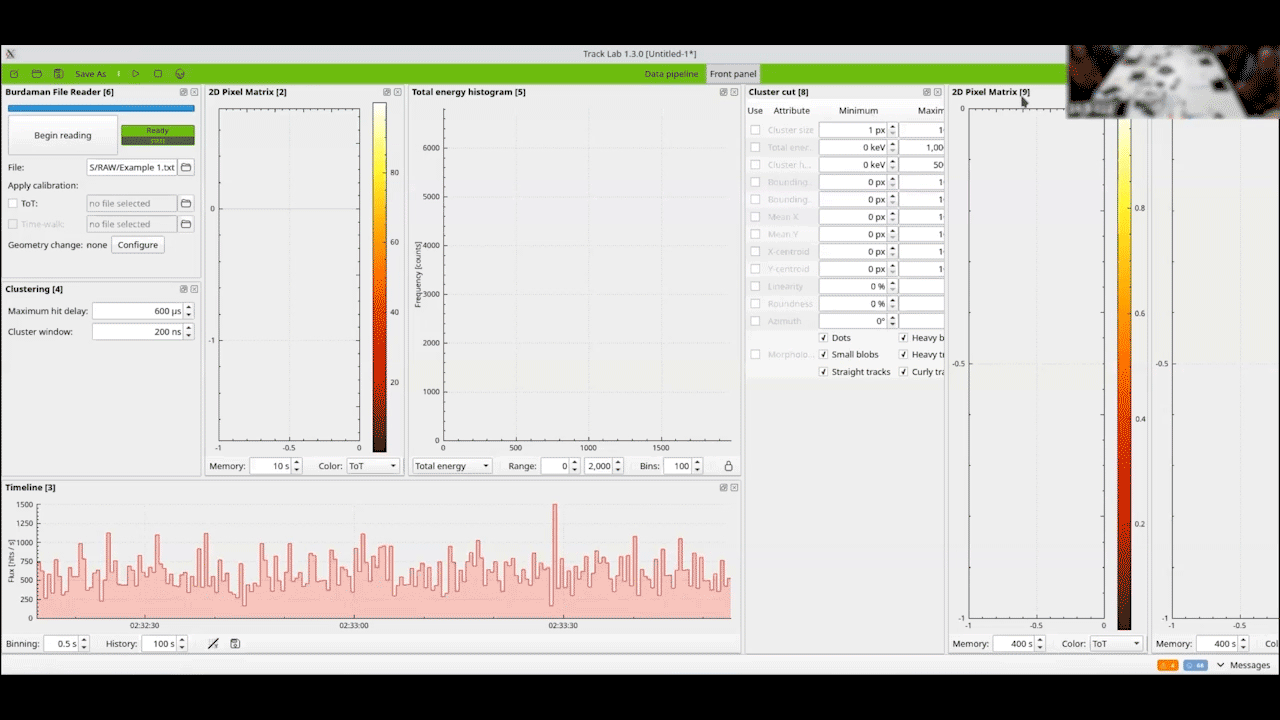Track Lab
How Docking Panels Made Physics Data Analysis Software More Adaptable
At the Institute of Experimental and Applied Physics, Czech Technical University, researchers have developed Track Lab — a groundbreaking software for data acquisition and analysis. Designed for efficient operation in modern particle physics experiments (like at the Large Hadron Collider at CERN), Track Lab is a flexible tool that empowers scientists to construct data workflows by graphically connecting modular elements in its user interface, such as filters, plotters and file writers. This permits measurements to be conveniently visualized during acquisition, and filtered in real time to conserve computing resources that are often in short supply. A key milestone in Track Lab’s development was the integration of KDDockWidgets, a docking system library by KDAB, which transformed the user experience towards increased versatility.
Overcoming Initial Challenges
The team’s original challenge centered on finding acceptable balance between performance and versatility. As the lead developer Petr Mánek explains: “The largest pain point lay in delivering analysis features that could adapt well to users’ evolving needs without compromising data processing speed.” For that reason, early Track Lab versions were restricted to a linear “source-to-sink” workflow, where each data processing element could be used at most once. While this kept the performance appreciably high and the user interface simple and clean, it severely constrained the range of potential applications. For example, one could not easily filter data and then visualize the results without using an auxiliary file, which was needlessly cumbersome. To address this limitation, the team completely overhauled Track Lab’s core in v1.0, its first major public release, which added support for daisy-chaining. This allowed workflows to be modeled as trees, which could capture much more complex topologies and thereby unlock a broad range of previously inaccessible applications. However, this new degree of freedom also introduced a major user interface challenge: managing an ever-changing array of interactive panels that controlled individual processing elements.

Example of flexible window docking in Track Lab
Why KDDockWidgets? A Modern Way to Implement a Well-known Feature.
To cope with increased complexity and dynamism in Track Lab’s interface, its developers were searching for a solution that would permit users to move panels around the window and customize their layout at runtime, depending on application. Such a docking system, sometimes referred to as Multiple Document Interface (MDI), was readily provided by the underlying Qt Widgets graphical library. Unfortunately, this option was not viable for Track Lab, as the software had only recently transitioned to Qt Quick, which supersedes Qt Widgets in the latest version, but does not ship a suitable replacement for MDI. The team therefore sought a modern, sustainable solution. “We needed a docking system that worked seamlessly with Qt Quick to future-proof Track Lab,” notes Petr. KDDockWidgets emerged as the ideal choice, offering:
- MDI-like flexibility for arranging panels into grids or tabs.
- Smooth and efficient interoperability with Qt Quick.
- Robust serialization, enabling users to save and restore entire workspace layouts.
The active development cycle and professional support offered by KDAB further cemented the decision.
Benefits for Developers and Users
For the Track Lab developers, KDDockWidgets eliminated the need to build a custom docking system—a task the team estimated would have consumed months of effort. Instead, they focused on refining their product's data processing capabilities.
For end-users, the library delivered a polished experience, similar to modern Integrated Development Environments (IDE):
- Dynamic panel docking and floating for personalized layouts.
- Effortless workspace persistence via serialization.
- Enhanced performance, even with dozens of active panels.
„KDDockWidgets gave our users the sophistication of commercial tools without requiring us to reinvent the wheel,” remarks Petr.
Data processing pipeline servicing six Timepix3 detectors at ATLAS, CERN
Dockable panels showing live data acquired at ATLAS, arranged using KDDockWidgets
An analysis panel layout, which plots attributes of detected tracks (energy vs. area) in a 2D histogram
An analysis panel layout, demonstrating Track Lab's capability to filter tracks in real-time while measurement is ongoing
A diagnostic panel layout, which shows correct response of a Timepix3 detector to change of configuration parameters
A commonly used calibration panel layout, which is used to equalize 65,536 pixels of a single Timepix3 detector, enabling them to measure together with similar response
Looking Ahead
Track Lab’s adoption of KDDockWidgets has set a new standard for scientific software in its category, allowing its users to customize the program for its intended use, while maintaining desirable high-performance properties, necessary for modern physics research. For researchers seeking a versatile, scalable data acquisition and analysis solution, Track Lab offers a compelling platform—one that evolves with the needs of modern science. Explore Track Lab’s capabilities and learn how KDDockWidgets can elevate your own projects via KDAB.

